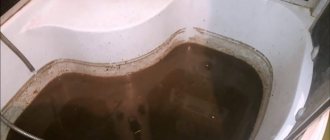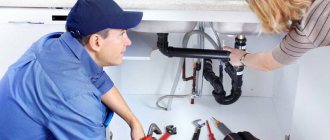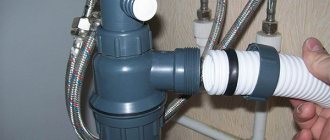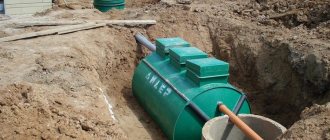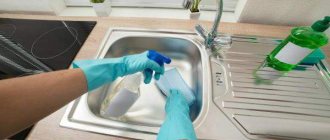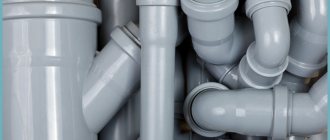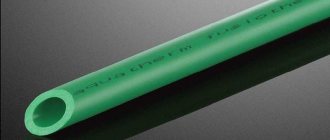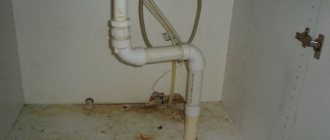Sewerage is far from being a bottle of perfume; its composition is such that it emits extremely unpleasant, sharp and persistent odors. To protect against unpleasant odors, they came up with a sewerage device called a water seal.
This simple device reliably cuts off the internal space of the drain from the living space, saving the inhabitants of the house from unpleasant contact.
How does a siphon work and on what principle does it work?
Wherever this device is located, its purpose is always the same:
- compensation of hydraulic shocks to limit loads on the gravity sewage system;
- preventing foul-smelling air from entering the living space from the drain system.
If the hydraulic valve is selected correctly and installed in accordance with the requirements for it, clean air is maintained in the room, and the sewage system works for a long time without failures. This can be achieved by knowing what a water seal in a sewer is and using it correctly.
The designs of closing devices are different, but, in general, it is a product made of pipes, in the bend of which water is stored, blocking the lumen along the inner diameter.
The water plug is constantly inside the pipe, periodically renewed. During a long break, the liquid in the hydraulic seals gradually dries out, allowing the smell to enter the room. This phenomenon is typical for buildings that are periodically visited, for example, country houses.
All elements of the sewer system are interconnected. For example, a drain pipe prevents “siphon failure” - drawing water into the riser during descent by equalizing the pressure in the sewer pipe. Air valves of various designs are also used for the same purpose - see installation features, types and manufacturers. They are used when there are no vent pipes in the building structure.
Differential devices
Their purpose is to change and regulate the flow rate of sewer water and the filling level of pipes. Drop wells are installed in the following cases:
- In order to reduce the penetration of the incoming pipeline into the ground.
- When there is a possibility of a sudden change in flow speed.
- When a sewerage pipeline crosses underground obstacles.
- If the well is the last one when discharging waste water into a receiving structure or reservoir and the outlet is below the mirror level.
Depending on the tasks being solved, these devices are equipped: the drops can be tubular with a vertical arrangement, supplemented with a water-drain barrier, multi-stage (cascade), with a large slope to accelerate the flow. In the same row of differential devices there are also wells equipped with a water seal.
What are the types of hydraulic valves for sewerage?
Many designs of interrupting devices for drainage systems have been developed and are in use.
Watch the video
Their classification is possible taking into account various properties, but mainly takes into account design differences. Thus, up to six main types of sewer water seals are distinguished.
Hydraulic elbow valves
This device is easily identified by its appearance - they have the shape of the Latin letter U. The advantage of devices of this shape is their strength, which allows you to freely install the system without fear of damage.
Most often, siphons of this type are used for installation on bathtubs and sinks. The material used to make the hydraulic valve is plastic or metal.
Simple plastic inserts are often disposable and cannot be adjusted. When dismantling, they are usually simply cut out.
Composite products allow you to adjust the position of the pipe by changing the relative position of the elements.
The knee is made with two bends - inlet and outlet, with the point of the second of them located 5-6 centimeters below the first. If cleaning becomes necessary, you can use several methods:
- with complete disassembly of the product, or;
- using a flexible cable with a brush at the end.
Some modifications are equipped with an additional inlet, which can be used when connecting a dishwasher or washing machine.
Bottle type devices
Siphons of this design are most often used in kitchen sinks.
They are designed in such a way that the flow of used water comes to the bottom of the casing, and then rises up through the gap. In this case, solid fractions in the form of food residues are deposited. As they accumulate, they are removed by removing the casing. To do this, simply unscrew the union nut, remove the container and clean it of dirt.
Then you need to wash it with hot water and detergents to remove fatty deposits on the inner surface of the walls. Before installation, the threads must be sealed with silicone sealant.
At the same time, such a siphon fulfills its main purpose - protecting the room from the penetration of sewer gases.
Bottle designs also ensure the integrity of jewelry, especially rings, which easily fly off the soapy finger of the hostess and settle at the bottom of the sump.
Double-turn hydraulic valve
Such a device is similar to the knee analogue, but its configuration is more complex. The drain part of the pipe is connected to the outlet pipe of the plumbing equipment, and a special mesh is installed at the connection point to trap hair and animal fur in the drain.
Next, it goes into an elbow and, at an angle, joins another pipe, which is directed to the sewer drain. The main place where valves of this type are formed are bathrooms.
Some models of the double-turn design are equipped with inspection holes, which allow inspection and prompt cleaning in case of blockage.
The material for the manufacture of double-turn hydraulic valves is most often polypropylene, but elite-class products can be made of brass with a chrome-plated surface. When working with such products, you need to use a special tool with soft sponges so as not to damage the mirror surface of the products.
Corrugated siphons
Water seals in a sewer pipe can be made of flexible corrugated pipe. Such devices are very convenient for installation in cramped conditions. Using the plasticity properties of the material, such a siphon easily fits into the narrowest cracks.
This distinguishes such a pipeline from a system of rigid pipes. At the same time, the material – polypropylene – is strong enough for use in non-pressure and low-pressure drain systems.
Corrugated pipe siphons are popular when used in the bathroom, where, as a rule, there is not enough space, because you need to install not only the main drain pipe, but also an overflow hose. In addition, a hydraulic valve must be formed from it.
When choosing a siphon of this design, you need to take into account the property of the inner surface of the corrugated pipe, which actively traps all types of pollution that are possible in wastewater. Therefore, you need to install a fine mesh filter on the drain funnel.
A hydraulic shutter for sewerage made from a corrugated tube requires constant maintenance related to the removal of internal contaminants, otherwise it becomes rigid and cracks appear at the bends of the corrugation.
Overflow systems
The design of such a unit protects the home from flooding. In a situation where the drain hole is blocked for one reason or another, it is the overflow that will save you. This is familiar to everyone, especially in the situation with a bathroom or kitchen sink.
Of course, you will have to pay for the water that goes into the overflow device, but this is cheaper than making unexpected repairs not only in your apartment, but also in your neighbors’.
Dry water seals for sewerage
While solving a similar problem as hydraulic valves, a dry valve works completely differently. It uses the “nipple” operating principle.
Water enters through a pipe in which a check valve is installed. Thus, the water remains in the pipe in any situation, and the bad smell from the sewer does not have the opportunity to leave it.
It is advisable to use such a device in a bathhouse, where hydraulic devices are prone to drying out.
Dry seals should absolutely not be used in a kitchen sink, where they simply cause clogs, but these products are effective in shower stalls.
There are several types of dry shutters:
- Membrane, which covers the hole when water leaves with an elastic membrane.
- Pendulum, quickly closing access to the hole.
- Float valves, which operate on the same principle as in a cistern.
Sewer drain with water seal
The installation of such a unit is carried out in rooms where drainage is made from the entire surface of the floor. Previously, at the construction stage, a sealed floor screed is installed, in which a siphon is installed to prevent air from entering from the sewer.
However, in the case of a sewer drain, it is necessary to take into account long-term downtime of the room, which is especially true for shower rooms in bathhouses. In this case, when the water in the seal dries out, air from the sewer freely penetrates into the room.
Therefore, in addition to a water seal, it is also common practice to install a dry siphon in baths. It is not a special device and is mounted as part of the sewer drain structure. Such a valve is guaranteed to close the drain hole even without water.
How to choose
The choice of siphon design is influenced by various factors:
- sewer pipe diameter;
- size and availability of space to place the device;
- material and availability of additional connecting pipes;
- presence (or need) of overflow.
Water seal for sewerage 50 is necessary for bathtubs, washbasins, kitchen sinks, dishwashers or washing machines. The horizontal pipeline for these devices has a diameter of 50 mm, sufficient to drain wastewater from these devices. For toilets, risers, or in other situations, a water seal for sewerage 110 is required, designed to cut off a large pipe diameter and with the appropriate dimensions. 110 mm pipes are usually used for the vertical part of the system. A water seal on them is possible only in the lower, basement part, as a cutoff from biogas from an external system or its own treatment plant. As a rule, the choice of such elements is made at an early stage, while the house is still being designed. The main selection criteria are reliability, ease of installation and low cost of the device.
Choosing a water seal for sewerage
The modern construction market offers a wide range of siphons, which may differ according to various criteria:
- According to the material of manufacture.
- Traditionally, water seals were made from cast iron. The material is very durable and strong, not exposed to aggressive environments. The disadvantage of such siphons is the rough inner surface, which tends to retain various types of pollution, and especially fatty inclusions.
A siphon made of cast iron must be equipped with an inspection window so that the sewer can be cleaned without its complete installation.
Hydraulic valves in this design are currently still used in industrial construction.
1.2.
The most popular water seals are made of plastic, which is facilitated by the relatively low price of these products. Not the least role is played by their high consumer qualities - smooth inner surface, chemical inertness. In addition, siphons made from plastic pipes are technologically advanced - they are easy to assemble and adjust to their location. Do-it-yourself water seals for sewerage are most often made from this material.
You need to pay attention to the plastic water seal made of corrugated pipe. When installed, they can be given almost any shape and bending direction, which allows them to be used in cramped locations.
1.3.
Metal products made of bronze or brass, electrochemically coated with a layer of nickel, are popular. This is done not only for decorative purposes, but also allows you to extend the life of the reinforcement, preserving the surface from oxidation.
Installation of such plumbing fixtures must be carried out with extreme caution, using a tool with plastic jaws to avoid scratches on the mirror surface of the products.
1.4. Water seals and other stainless steel plumbing fittings can be considered special-purpose products. They are used in children's and medical institutions, in public catering establishments. This is done to use the basic properties of the material - it is easily washed and easily disinfected.
- For special qualities.
2.1. If you are selecting a water seal for a kitchen sink, you need to opt for a bottle design. This device allows you to quickly remove the outer storage container and clean its interior from food debris from the kitchen sink, or even retrieve a gold ring that has slipped off a wet finger.
2.2. When choosing a drain for a shower, kitchen or bathroom, you should take into account the frequency of use of these rooms. If they do not work for a long time, the water seal dries out with predictable consequences. Therefore, for a summer residence, all drains must be additionally equipped with dry seals.
2.3. When connecting bathtubs to the sewer system, it is most convenient to use a water seal made from a corrugated hose, given its ability to be placed in the tightest places.
When choosing a water seal for sewerage, you should take into account not only the features of the installation site, but also take advantage of the advantages provided by the design and other features of the devices.
Watch the video
Prices for various models
Connecting the dishwasher to the water supply and sewerage
The price of a water seal for sewerage is determined by several components:
- material (metal is more expensive than polypropylene);
- manufacturer (the most expensive European models);
- complexity of the device (bottle ones under the sink are the cheapest, and overflow devices and devices with several drains are more expensive).
Approximate prices for different models are presented in the comparison table below.
| Purpose | for the sink | for toilet | for Bath | for kitchen sink | ||||
| models and prices in rubles | AlcaPlast A410 | 270 | Corrugation AlcaPlast A97 | 300 | Geberit bend 152.439.46.1 | 2510 | Waste-overflow Viega 572853 | 250 |
| AlcaPlast A431 | 870 | Corrugation AlcaPlast A97 | 340 | Geberit bend 152.439.46.1 | 1380 | Orio 3 A4011 | 701 | |
| AlcaPlast A400 | 1960 | Elbow AlcaPlast A90-90 | 220 | Drain and overflow AlcaPlast A501 | 510 | Wirquin medium 1 1/2″x40 mm | 152 | |
| AlcaPlast A437 | 1210 | Geberit bend 152.438.46.1 | 2460 | Drain and overflow Ravak X01318 | 3430 | Wirquin without outlet d 40 mm | 248 | |
| Hansgrohe Flowstar 52105000 | 4470 | Geberit bend 152.439.46.1 | 3380 | Waste-overflow Viega 572853 | 3920 | Orio with waste and two bowls d 40 mm | 223 |
Installation of water seal on sewerage
The siphon devices produced today are so clear and simple that installing them in place in the system is extremely simple and anyone can do it themselves. Let's look at a few examples:
- A self-formed water seal device can be made from a piece of pipe and several standard fittings.
The use of additional sealing in the form of sealant will ensure long-term operation of the device.
- In the same way, a drain connection is formed in a shower or bathroom, and it can be connected directly to a collector pipe with a diameter of 110 mm.
If cleaning is necessary, the device is simply dismantled and then put back together.
Considered the most difficult to install, a bathtub water seal can easily be made using a corrugated plastic hose. The corrugation is used for the overflow device, which is also a mandatory element of the plumbing piping of the bathtub, and the siphon can be used either as a single piece, selected according to size, or from the same hose. The inconvenience of working in cramped spaces forces us to pay special attention to the quality of installation of fasteners - without distortions and strictly according to the thread.
- The easiest way is to connect a bottle water seal to the kitchen sink.
To do this, you need to install the upper funnel into the hole in the sink and tighten the clamping nut. Before this, a gasket is installed under the funnel. Do not over-tighten the nut; it may dislodge the gasket from its conical seat and cause a leak.
After this, the casing is put on the pipe and secured with a nut. The corrugated pipe is led from the body to the inlet rubber bushing at the opening of the sewer pipe. The sleeve is selected to match the outer size of the hole, and the inner size to match the diameter of the corrugated pipe tip.
Just in case, it is better to treat the seats with silicone sealant. To complete this connection it will take about 15 minutes.
Watch the video
How to make water seals with your own hands
The need for a siphon in the sewerage system is absolutely obvious. How to make this simple but important detail with your own hands? To do this, it is best to use standard fittings of the required size. Of course, you need to have the skills to solder plastic pipes using special equipment - a soldering iron.
Watch the video
But this is a simple art and learning it is not difficult and does not take long. The device can be rented on a daily basis without spending any money on purchase.
How to quickly eliminate odor
The lack of water in the toilet water seal can be detected with the naked eye. To remove an unpleasant odor, simply drain the water, creating a clean water plug. If the water level in the drain remains low, then the problem lies in improper installation (siphon, drain pipe, etc.).
If the problem persists after filling the water seal, then the ventilation and sewer systems should be cleaned. If you suspect a leak, you should inspect the joints and then wrap them with toilet paper. A change in the color of the adsorbent will indicate a depressurized connection.
If home measures have no effect, it is necessary to call specialists who will determine the area of the leak or improper installation of pipes . To search for damage, special devices are used: thermal imagers, acoustic leak detectors, etc.
If the smell is due to the presence of a hidden sewer leak, then the owners will have to dismantle the cladding and part of the ceiling.
Improved ventilation draft
Cleaning the ventilation duct is performed in the following sequence:
- Remove the decorative grille. Clean it from dust, dirt and cobwebs, rinse thoroughly.
- Wear gloves and sweep out small and large debris from the ventilation duct.
- Clean the canal deeply with a dry and clean toilet brush. Vacuum the remaining dust and cobwebs with a pipe without attachments.
- Clean the canal walls from dirt using a damp sponge and scraper. Detergents and chemical solvents are not recommended.
- Reinstall the clean decorative grille. Check the ventilation draft.
- For more thorough cleaning, you can use a flexible shaft and a stiff brush, the diameter of which is approximately equal to the width of the ventilation duct. The structure of the shaft and brush is put on the drill, which rotates at low speeds. Before starting work, it is recommended to mark the height of the floor with the ceiling on the cable. When the end of the brush hits a solid obstacle and the mark reaches the exit of the channel, the shaft can be removed.
Ventilation needs to be improved.
If there is no draft even after cleaning, then the problem may occur in several apartments or on all floors. To “break through” a ventilation duct in a common building system, you need to call specialists from the management company or the housing office.
Home methods for cleaning pipes
If an obstacle occurs in the pipeline, the water in the water seals is not renewed, and the incoming waste begins to decompose and emit a stench.
You can get rid of the blockage using the following means:
- Table salt and soda. The method is only suitable for preventing blockages and gently cleaning the walls of the sewer. You need to pour 150-200 g of salt and soda into the drain, add hot water and leave for 2-3 hours. The product is used to clean sink drains. More effective chemicals are required to dissolve hair and impurities.
- Vinegar and soda. The problem may arise not in the bathroom system, but in the apartment’s general sewer system. In this case, the likely cause of the blockage is fatty deposits. They are effectively eliminated with a combination of vinegar, baking soda and hot water. To clean the pipe, you need to remove the metal mesh from the drain hole, pour 100-150 g of soda into it and pour in 200-250 ml of vinegar (6%). After this, close the drain with a stopper and wait 2-4 hours. The last step of the procedure is pouring 1-1.5 liters of boiling water. The cleaned drain is washed with running water.
- Soda and plunger. The combination of home remedies and mechanical action allows you to do without strong chemicals. First you need to pour 1 liter of boiling water into the pipe, wait 10-15 minutes and use a plunger. If it was not possible to break through the blockage, you need to pour 150-200 g of soda into the drain, pour 1 liter of boiling water, wait and use the plunger again. The procedure can be repeated 2-3 times.
- Plumbing cable. A flexible steel rope with a hook attachment is suitable for removing dense blockages and large debris. To clean the drain, it is screwed in and pushed into the pipe until the obstruction disappears. It is not recommended to pierce corrugated connections with a cable, because a sharp nozzle can tear thin walls.
- Chemical reagents. Tornado, Bagi Potchan and Mr granules are used to remove blockages. Muscle, Chirton powder, liquid Mole, DEBOUCHER Active and Synergetic, Sanfor, Chistin, Tiret and Sanox gels. Some products (for example, Tiret) are not intended for cleaning toilet drains. Reagents are poured or poured into the drain hole. After 5-15 minutes of action, the sewer is washed with hot water.
For thorough cleaning, it is recommended to remove the corrugation or disassemble the siphon. Flushing the pipeline section will remove grease, dirt and organic waste from the walls.
Sealing joints
To ensure tightness, it is necessary to promptly change the rubber gaskets and treat the joints with plumbing sealants. The most common type of sealant is polymer paste. Based on their composition, pastes are divided into silicone, silicone-acrylic, acrylic, polyurethane and bitumen.
The most reliable products are produced by Tytan, Ceresit, Ciki Fix, S 400, Krass, Dow Corning, Belinka and Moment.
Sealing is performed as follows:
- Both joint surfaces are washed from dust and dirt, cleaned and degreased.
- The sealant is applied to one of the surfaces in a circle in a continuous seam.
- The composition is kept in air if the exposure is provided for in the instructions.
- The elements are overlapped, the connection is left for 8-10 hours for complete polymerization.
Instead of sealing paste, you can use a shrink sleeve or plumber's tape. The polymer tape is overlapped with a margin of 0.5 width.
To repair pipe damage, repair clamps and patches made of bitumen mastic are used. If the corrugation breaks, patches are not applied, because Replacing this element is cheaper and more reliable than repairing. The joint between the new part and the toilet bowl is treated with sealant, and the edge of the corrugation with a sealing ring is installed in the sewer outlet.
After polymerization of plumbing glue, it is recommended to check the tightness of the connections. To do this, you need to pour 10-15 liters of water into the sewer, monitoring for leaks at the treated joints.
Similar articles
Proven methods for cleaning acrylic surfaces from various contaminants
Rules for cleaning and caring for bathroom faucets
How to clean tiles from grout and glue
What to do if there is an unpleasant odor?
The bathroom should smell pleasant; the aromas of fragrant shampoo and shower gel are appropriate here, but the smell of sewer gases here, and in any other room, is completely inappropriate. Let's look at how to eliminate sewer smell in the toilet and bathroom. To do this, you must first identify the cause of its appearance.
You have discovered that the smell of sewage in the toilet has become unpleasant, what should you do in this case to get rid of the “odors”? The first thing that usually comes to mind for people who are inexperienced in sewerage issues is the use of air fresheners. Of course, for some time the aroma of the freshener will be able to cover up the smell of the sewer, but it will not be able to eliminate it.
Also, it might be a good idea to wonder if sewer smell is harmful? In addition to pathogenic organisms, substances such as ammonia, hydrogen sulfide, mercaptans, sulfur oxides, etc. can penetrate into an apartment with sewer gases. Naturally, inhaling such gases cannot be called beneficial. Therefore, when a smell appears, you need to figure out why the toilet smells like sewage.
What means can you remove the smell from?
Until the cause of the odor from the sewer is determined with 100% certainty, it is recommended to use special products that temporarily eliminate odors.
Dispenser
Aerosol can or dispenser. Both of these options will help you figure out how to eliminate the smell from the sewer in the toilet. They can be placed on the floor or mounted on the wall of the bathroom. The difference lies in the fact that the aerosol is sprayed by pressing the valve of the cylinder, and the dispenser operates automatically, based on specified periods of time. It is important to understand that the dispenser and aerosol will only remove odors from the drain for a while. An alternative means is considered to be a freshener based on gel filler. This product deodorizes the bathroom for several months.
Blocks
Blocks attached to the toilet, as well as stickers in the shape of stripes. To remove the smell from the toilet, many apartment owners use special stickers. This product fills the air with incense and is endowed with antiseptic properties, that is, it fights against bacteria. When a stream of water hits the sticker, a pleasant and fresh aroma appears in the bathroom. Even the most inexpensive sticker lasts for 450 washes. It should be noted that blocks containing a refreshing gel suspended from the toilet are effective in combating the disgusting smell of sewage. This product can simultaneously deodorize the air in the bathroom, as well as disinfect and clean the toilet. The product is easily refilled and works for one hundred flushes.
Special tablets
with a pleasant aroma for the drain tank. This product can effectively combat odor. The tablet simply drops into the tank. After all water drains, the product will refresh the room with a pleasant smell, effectively deal with bacteria and prevent the formation of rusty deposits on the plumbing. The main advantages over other means are the ability to use a large number of times, as well as adequate cost.
Water seal for a bath: types
Unlike conventional bathrooms and showers, baths use drains with increased capacity. That is, the size of the drain receiving grid is usually 100x100 m or even more, instead of the standard 60x60 mm. In this way, it is possible to ensure normal operation of the drain even with a large amount of soap and dirt residues.
In addition, you have to take into account the size of the bathhouse, the design of its floors and the frequency of use. Therefore, several water seal schemes are used for the drainage device:
- Classic bellows with U-shaped elbow;
- Pendulum or dry shutter;
- Float type of shutter;
- Controlled or transom drain option.
The first and third types of water seals are classified as “wet” types of devices; for their normal operation, the presence of a sufficient amount of water in the system is extremely important. The second and fourth are classified as “dry” devices; they work equally well in baths, both under normal conditions and when there is a lack of water in the drain chamber.
Criteria for choosing a dry siphon
In order to prevent mistakes when choosing a shutter model in a particular case, the following factors must be especially carefully considered. The main conditions of which, when choosing, should be the following:
- A fairly important indicator for choosing the required dry seal for sewerage is the amount of waste that will pass through it. For example, a dry shutter with a passage diameter of 50 mm is well suited for a washbasin. For showers or baths, valves with a larger throughput capacity will be required. In such cases, it is necessary to purchase a device with a passage diameter of 100 mm.
- The second condition that must be taken into account is the height of the device. Horizontal bends, as a rule, have a height of 7 to 10 cm, while vertical bends require more free space (about 15-18 cm). Therefore, if you do not want to carry out installation in cramped conditions, it is best to choose a horizontal model.
Helpful information! When purchasing this device, you need to pay attention to the little things. It is advisable to make sure that the device is working. This is done quite simply - you just need to pass a certain amount of water through it.
Don't forget about the appearance of the device. Shower drains, the design of which includes dry seals, can be equipped with a grate of any configuration. There are quite a lot of design solutions in this situation. This allows you to turn the device into a decorative product that will delight with its aesthetics.
What is a water seal and how it works
This is a simple device consisting of a curved tube (siphon), the lower part of the bend is located below the drain hole and the water removal point. There is water inside, which creates a plug and prevents odors from penetrating from the system.
Any plumbing fixture is equipped with water seals: sink, sink, toilet, bathtub, etc. When draining, water enters the siphon and displaces the water that was previously there. Thus, the liquid in the water seal itself is purified and the proliferation of microorganisms is prevented.
The flow of drained water calmly passes through the elbow, and the height difference eliminates the possibility of draining it. The design of this device is so effective and simple that there is no point in looking for additional solutions to combat odor.
On a note!
If there is a smell from the sewer in the house, check to see if the liquid from the siphon has evaporated or it has broken down (burst). In this case, it must be replaced.
